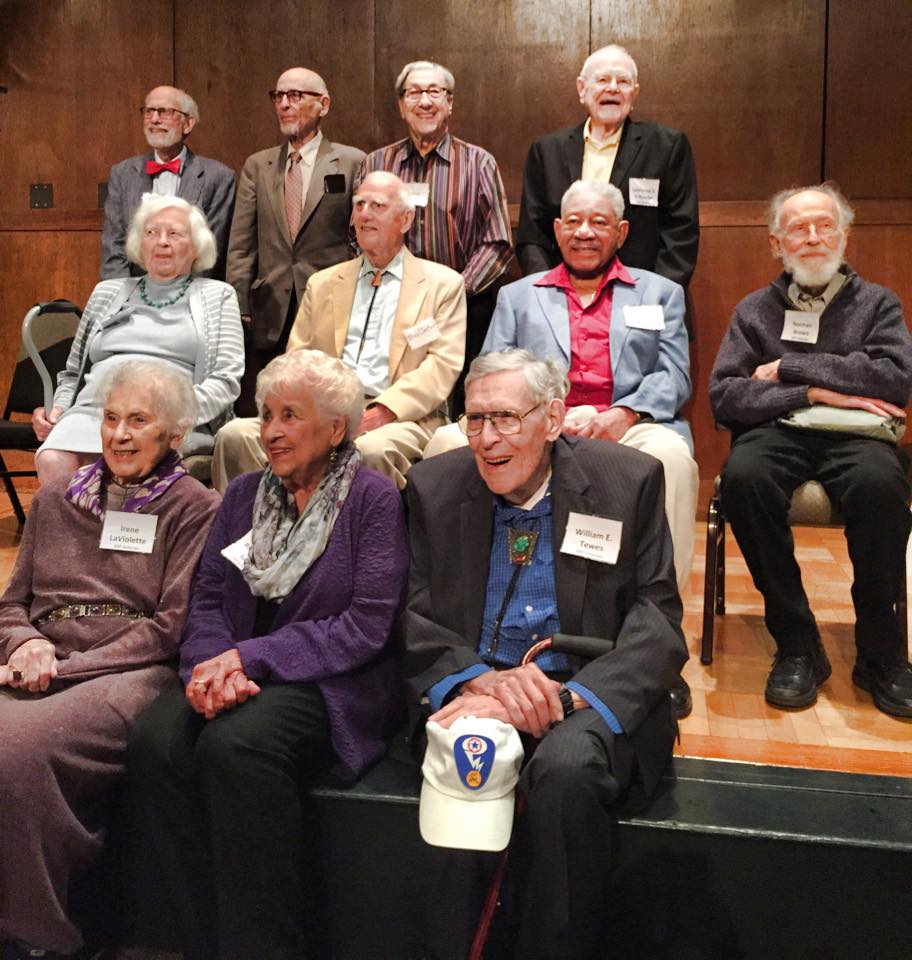Manhattan Project Veterans Reunion
On Tuesday June 2, 2015 Manhattan Project veterans and their families gathered at the Carnegie Institution for Science in Washington, DC to commemorate the 70th anniversary of the Manhattan Project. More than a dozen veterans from across the country took the stage to discuss their role in the Manhattan Project and how sites at Los Alamos, Oak Ridge, Hanford, Chicago, and New York City contributed to the top-secret effort to build the world’s first atomic bomb.
Lawrence S. O’Rourke, William E. Tewes, and James Forde recalled working at Columbia University’s top-secret gaseous diffusion research facility in the Nash Garage Building on the Upper West Side of Manhattan. “We were tasked with developing a special barrier that could separate the fissionable uranium-235 isotopes from the more abundant U-238,” remembered O’Rourke.
Forde, the lone African-American at the facility, was responsible for cleaning the laboratory equipment and had no idea what scientists were working on. On Tuesday, he was reunited on stage with O’Rourke and Tewes. “Thanks for finally telling me what I was working on!” Forde quipped.
Manhattan Project National Historical Park
The 70th anniversary events continued on Wednesday, June 3 with a daylong symposium featuring a discussion of the new Manhattan Project National Historical Park.
Richard Rhodes, historian and author of the Pulitzer prize-winning book, The Making of the Atomic Bomb, discussed the importance of preserving historical sites in his opening remarks. “We preserve what we value of the physical past because it specifically embodies our social past,” Rhodes explained. “That social reality is anchored to physical objects, extending far and deep into the physical world of landscapes, buildings, documents, machines and artifacts. These Manhattan Project historical sites are among the world’s most significant, places where work was done that changed the human world forever.”

Senator Martin Heinrich, who helped pass legislation that established the Manhattan Project National Historical Park in December 2014, echoed these sentiments in his speech to attendees and thanked veterans for their service to the nation.
Next, officials from the National Park Service and the Department of Energy discussed the timeline for the new Manhattan Project National Historical Park. They also fielded questions from the audience about how the complex history of the Manhattan Project might be interpreted. Patrick Gregerson, Chief of Planning for the National Park Service and Jamie Shimek, Deputy Assistant Secretary for Senate Affairs for the Department of Energy assured attendees that both departments would “welcome public participation” to reach a “balanced and inclusive interpretation” of Manhattan Project sites and their history.
Manhattan Project Symposium
The symposium also featured panels with Manhattan Project veterans and experts discussing topics such as innovations, espionage, and women and the Manhattan Project.
Alex Wellerstein, a Professor of Science and Technology Studies at the Stevens Institute of Technology in Hoboken, NJ delivered a fascinating presentation on some of the incredible innovations that came out of the Manhattan Project. “There were over 5,600 different inventions relating to the atomic bomb, with some 2,100 separate patent applications ready to filed – in secret,” reported Wellerstein.
In a panel on espionage, Robert S. Norris, author of Racing for the Bomb: General Leslie Groves, the Manhattan Project’s Indispensable Man,” discussed the intelligence revolution initiated by General Leslie R. Groves that took security measures to unprecedented heights. “Groves wanted complete control,” argued Norris, “and he achieved that by making sure everything was compartmentalized.”
Inevitably, spies still slipped through the cracks. Manhattan Project veterans Ben Bederson and James Schoke discussed their encounters with Soviet spies, including Klaus Fuchs, Ted Hall, David Greenglass, and George Koval. Schoke, who travelled to different Manhattan Project sites to train physicists how to use radiation detection equipment, remembered having lunch with Koval on a trip to Dayton, Ohio. “He was a nice guy!” recalled Schoke, “I never once suspected him to be a spy.”
In the following session, Kai Bird and Martin Sherwin, co-authors of the Pulitzer Prize-winning biography American Prometheus: The Triumph and Tragedy of J. Robert Oppenheimer, joined Robert Norris to discuss the leadership of General Leslie Groves and J. Robert Oppenheimer. Charles Oppenheimer, J. Robert Oppenheimer’s grandson, also participated in the discussion.
The ceremony closed with remarks from General Frank G. Klotz, the Department of Energy’s Under-secretary for Nuclear Security and NNSA Administrator. Klotz emphasized the importance of the Manhattan Project in shaping the ongoing efforts at the National Nuclear Security Administration today.
Thank You
The Atomic Heritage Foundation would like to thank all of the veterans and their family members who helped make the event such an incredible success. To learn more about the veterans, visit our “Voices of the Manhattan Project” website, which features interviews with many of the veterans and experts who spoke, including O’Rourke, Forde, Bederson, Rhodes, Norris, and more. Y-12 historian Ray Smith took some wonderful photographs of the event, which can be accessed here. To access the event program, please click here. We are very grateful to our corporate and individual sponsors, who made the event possible.
The Manhattan Project posters, notecards, and hats that were sold at the event are now available for purchase on our online store. Video of the events is now online on C-Span, and we will be getting more video online soon. You can donate to support our mission online here.





